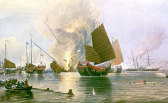| What are the processes of two opium wars? The first was between Great Britain and China. Great Britain, looking for the ending of China's restrictions on foreign trade, responded to attack several Chinese coastal cities by sending gunboats. China, unable to withstand modern arms, was defeated and forced to sign the Treaty of Nanjing (1842) and the British Supplementary Treaty of the Bogue (1843). These provided
| 
|
| that the ports of Guangzhou, Jinmen, Fuzhou, Ningbo, and Shanghai should be open to British trade and residence; in addition Hong Kong was ceded to the British. Within a few years other Western powers signed similar treaties with China and received commercial and residential privileges, and the Western domination of China's treaty ports began. In 1856 a second war broke out following an allegedly illegal Chinese search of a British-registered ship, the Arrow, in Guangzhou. British and French troops took Guangzhou and Tianjin and compelled the Chinese to accept the treaties of Tianjin (1858), to which France, Russia, and the United States were also party. China agreed to open 11 more ports, permit foreign legations in Beijing, sanction Christian missionary activity, and legalize the import of opium. China's subsequent attempt to block the entry of diplomats into Beijing as well as Britain's determination to enforce the new treaty terms led to a renewal of the war in 1859. This time the British and French occupied Beijing and burned the imperial summer palace. The Beijing conventions of 1860, by which China was forced to reaffirm the terms of the Treaty of Tianjin and make additional concessions, concluded the hostilities. |